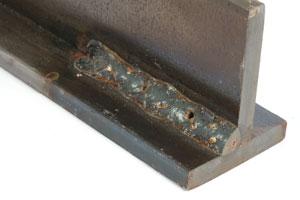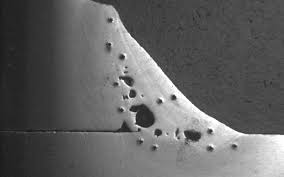Comprehensive Guide: What is Porosity in Welding and Exactly How to avoid It
Deciphering the Secret of Porosity in Welding: Tips for Decreasing Flaws and Maximizing Quality
In the elaborate globe of welding, porosity continues to be a consistent difficulty that can significantly influence the top quality and honesty of welded joints. As we dive right into the depths of porosity in welding, uncovering the tricks to its avoidance and control will certainly be paramount for professionals looking for to grasp the art of top quality weldments.
Comprehending Porosity in Welding
Porosity in welding, a common problem experienced by welders, describes the visibility of gas pockets or spaces in the bonded material, which can compromise the honesty and quality of the weld. These gas pockets are commonly trapped during the welding process as a result of various variables such as incorrect securing gas, infected base products, or wrong welding criteria. The formation of porosity can weaken the weld, making it at risk to splitting and deterioration, ultimately resulting in structural failings.
Comprehending the root creates of porosity is important for welders to effectively stop its incident. By acknowledging the importance of maintaining appropriate gas securing, guaranteeing the cleanliness of base materials, and maximizing welding settings, welders can dramatically decrease the probability of porosity development. Additionally, making use of techniques like pre-heating the base product, employing appropriate welding strategies, and carrying out thorough inspections post-welding can better aid in lessening porosity problems. On the whole, an extensive understanding of porosity in welding is important for welders to produce premium and durable welds.

Common Sources Of Porosity
When checking welding processes for potential quality problems, understanding the usual causes of porosity is crucial for keeping weld honesty and preventing structural failings. Porosity, defined by the presence of tooth cavities or spaces in the weld metal, can substantially jeopardize the mechanical buildings of a welded joint. One common root cause of porosity is improper protecting gas coverage. Poor securing gas circulation rates or inappropriate gas mixes can lead to atmospheric contamination, resulting in porosity formation.
Additionally, welding at improper parameters, such as excessively high travel speeds or currents, can generate extreme turbulence in the weld pool, capturing gases and causing porosity. By dealing with these common causes with proper gas shielding, material preparation, and adherence to ideal welding parameters, welders can reduce porosity and improve the high quality of their welds.
Techniques for Porosity Avoidance
Applying efficient preventative steps is critical in lessening the occurrence of porosity in welding procedures. One technique for porosity avoidance is ensuring proper cleansing of the base metal prior to welding. Pollutants such as oil, grease, corrosion, and paint can lead to porosity, so comprehensive cleansing using proper solvents or mechanical methods is essential.

One more secret safety net is the choice of the ideal welding consumables. Utilizing my site top quality filler materials and securing gases that appropriate for the base steel and welding procedure can considerably minimize the danger of porosity. In addition, maintaining appropriate welding parameters, such as voltage, present, take a trip speed, and gas circulation price, is crucial for porosity avoidance. Departing from the advised setups can cause improper gas protection and insufficient blend, resulting in porosity.
Furthermore, using correct welding methods, such as maintaining a consistent traveling rate, electrode angle, and arc length, can help prevent porosity (What is Porosity). Ample training of welders to guarantee they comply with best techniques and quality assurance procedures is additionally essential in minimizing porosity flaws in welding

Finest Practices for Quality Welds
Ensuring adherence to sector requirements and proper weld joint preparation are basic elements of achieving consistently high-grade welds. Along with these foundational actions, there are a number of best techniques that welders can carry out to even more boost the high quality of their welds. One key technique is preserving correct tidiness in the welding area. Pollutants such as oil, grease, corrosion, and paint can negatively affect the high quality of the weld, resulting in issues. Completely cleansing the workpiece and bordering area prior to welding can aid mitigate these issues.
Another best practice is to carefully select the appropriate welding parameters for the specific products being signed up with. Correct parameter selection makes sure optimal weld penetration, fusion, and total useful content top quality. Making use of top notch welding consumables, such as electrodes and filler steels, can significantly impact the last weld top quality.
Value of Porosity Control
Porosity control plays a critical duty in making sure the stability and quality of welding joints. Porosity, identified by the existence of tooth cavities or voids within the weld steel, can dramatically jeopardize the mechanical buildings and architectural integrity of the weld. Too much porosity deteriorates the weld, making it much more susceptible to fracturing, deterioration, and overall failing under functional loads.
Efficient porosity control is crucial for preserving the desired mechanical homes, such as strength, ductility, and durability, of the bonded joint. What is Porosity. By decreasing porosity, welders can boost the total high quality and you could try these out reliability of the weld, making sure that it satisfies the performance requirements of the desired application
Additionally, porosity control is vital for accomplishing the wanted visual look of the weld. Too much porosity not just damages the weld however also takes away from its aesthetic allure, which can be essential in markets where looks are very important. Correct porosity control strategies, such as making use of the correct securing gas, controlling the welding specifications, and making certain appropriate tidiness of the base products, are essential for creating high-quality welds with minimal flaws.

Conclusion
Finally, porosity in welding is a common problem that can compromise the high quality of the weld. By understanding the root causes of porosity and implementing correct avoidance strategies, welders can decrease defects and achieve better welds. It is important to manage porosity in welding to make certain the integrity and toughness of the last product. Implementing ideal methods for porosity control is important for accomplishing optimal welding results.